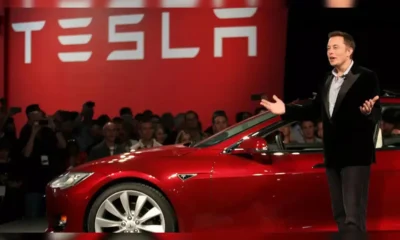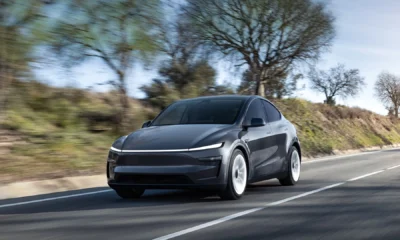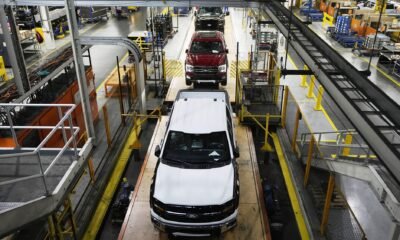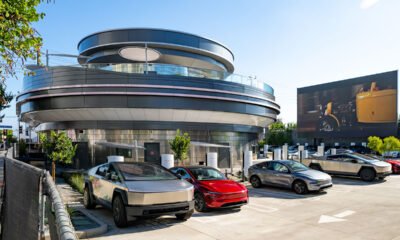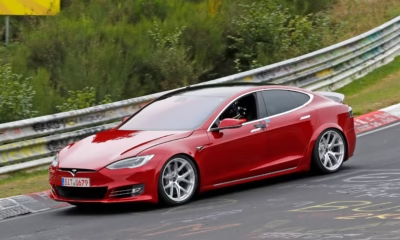Transportation
Tesla’s Surprising New Move Lets You Take Their Car Home for a Weekend but There’s a Catch
Electrify Expo and Tesla launch a first-of-its-kind ‘Weekender’ EV test drive — and thousands are lining up to see if an electric car truly fits their lives.

In a move that’s turning heads across the automotive world, Tesla has quietly teamed up with Electrify Expo to offer what many believe could be the game-changer for electric vehicle adoption in the U.S.: an entire weekend with a Tesla, no sales pitch, no pushy dealership follow-up — just you, the open road, and a chance to see if life with an EV actually works for you.
Electrify Expo, a popular festival that’s been educating and thrilling EV-curious crowds for five years, unveiled its ‘Electrify Weekender’ program this month. Unlike the usual quick spin around a parking lot, this demo lets festival attendees take a Tesla home, run errands, do the school run, or hit the freeway, all to answer the big question: Is it finally time to ditch gas for good?
“It’s an opportunity for our attendees… to have a no-pressure, non-sales-y experience,” Electrify Expo CEO BJ Birtwell told TechCrunch, highlighting what makes this different from the average test drive.
The concept is simple but powerful. Many potential EV buyers still hesitate because short test drives don’t reveal enough. Birtwell knows this first-hand — the festival’s quick demos, usually just 10 minutes long, have converted thousands already. Now, by handing over the keys for a whole weekend, he’s betting even the most skeptical drivers will be convinced once they experience the perks of daily EV life: silent drives, instant torque, and zero gas station stops.
Tesla, meanwhile, could use the extra boost. Amid a wave of tough competition and questions swirling around CEO Elon Musk’s reputation, the iconic EV maker hopes this partnership will sway the fence-sitters and refresh its fan base at a time when sales growth has cooled.
The Weekender kicks off June 21 at Electrify Expo’s Los Angeles festival before expanding to Seattle, San Francisco, Chicago, New York, and Dallas. Interested drivers will need a valid license and insurance — and of course, a willingness to return the car once the weekend thrill fades.
Birtwell hints more car brands are already signing up, positioning Electrify Expo as a neutral, no-pressure playground for EV window shoppers who dread dealerships. “If we’re going to drive broader EV adoption beyond half the population, that means we need to appeal to everybody,” he said.
For now, thousands are expected to jump at the chance. So if you’re curious whether a Tesla can really keep up with your grocery runs and Monday commute, you might want to clear your calendar for an Electrify Weekender soon — before every slot is taken.c
Transportation
We Need to Take More Care: WA Road Toll Hits 10-Year High After 5 Die in 24 Hours—Police Reveal Shocking Pattern Behind Fatalities
All of these deaths are preventable—WA Road Safety Commissioner urges drivers to rethink their choices as devastating holiday weekend leaves five families shattered.

Western Australia is reeling after five people tragically lost their lives on its roads within just 24 hours—marking a grim milestone in what has become the state’s deadliest year on record in over a decade.
The WA Road Toll has now reached 103 deaths, a devastating leap from the 93 recorded at this time last year. Officials warn that number will rise once the latest fatalities are officially added, pushing the state into its worst year for road deaths since at least 2014.
“This needs to be a wake-up call,” said Adrian Warner, Western Australia’s Road Safety Commissioner, in a public address outside WA Police Headquarters. “We need to be conscious about the choices we make when we get behind the wheel. All of these deaths are preventable.”
The tragic series of incidents unfolded just as school holidays began—a time when traffic surges and long-distance travel increase risks on the roads.
Five Dead in a Day: What Happened?
The deadly streak began on Thursday at 3pm in Australind, where a 70-year-old motorcyclist was killed after his bike collided with a tow truck at an intersection.
Just hours later, at 5:45am Friday, a 40-year-old man died when his Toyota Camry collided with a truck hauling three trailers in Mariginiup, a northern Perth suburb. The crushed remains of his vehicle paint a harrowing picture of the impact.
By 6:35am, a 51-year-old pedestrian in Mundaring was struck by a car and died on the scene. The morning had turned into a nightmare.
Then, in Serpentine, a 4WD struck a tree around 10:30am, catching fire. The male driver died before emergency responders could save him.
And at 2:30pm, a 64-year-old woman, a passenger in a car that hit a tree in Alfred Cove, died later in hospital from her injuries.
“It’s absolutely tragic,” said Commander Mike Peters of WA Police. “That’s five people that won’t be at Christmas this year—and five front doors our officers had to knock on to deliver that heartbreaking news.”
A Decade-High Toll with No Signs of Slowing
While every single fatality leaves a deep void, the scale of loss in just one day is stirring alarm among authorities. The state’s population has been growing at a rate of 3% annually, and with it, the road toll.
“The economy’s doing well, population is growing… and that’s putting pressure on our roads,” Commissioner Warner explained. “We’re doing everything we can—safer vehicles, tougher enforcement—but right now, it’s just putting a lid on a simmering pot. We need it to start boiling down.”
In response, the WA Government has vowed to uphold its 2030 road safety target—a 50% to 70% reduction in road deaths and serious injuries. But the recent spike shows just how steep the climb will be.
What’s Driving the Deaths?
Authorities are highlighting the “Fatal Five” causes: speeding, fatigue, alcohol and drug use, distraction, and lack of seatbelt use. While not all five deaths are confirmed to involve these factors, Commander Peters was firm:
“Those five causes are overrepresented in our fatal crashes every year. That’s not speculation—that’s fact.”
He also warned of heightened enforcement during the school holidays.
“You’ll see us out there with booze buses, speed cameras, and highway patrols. And I don’t apologize for it,” Peters said.
AI Cameras: The High-Tech Eyes on WA Roads
In an effort to change driver behavior, the WA Government has rolled out AI-powered traffic cameras at more than 100 locations across Perth since January. These cameras can detect mobile phone usage, seatbelt violations, and other infractions in real-time.
While only cautions are being issued during the trial phase, enforcement will begin in October, with fines expected to follow.
“We don’t want the money,” said Warner. “We want lives saved. And if a fine helps someone think twice before picking up their phone while driving—then we’ve done our job.”
One Man’s Mission: Allan Faulkner’s Roadside Memorial
In Albany, a man named Allan Faulkner has taken road safety into his own hands. Wearing high-vis gear, he’s placed a handmade roadside road toll sign beside a busy road, tallying the deaths and urging drivers to slow down.
His campaign—part vigil, part protest—is attracting attention from passersby and the media. Faulkner hopes that by seeing the number rise each week, drivers will remember: behind each digit is a shattered family.
Moving Forward: What Can Be Done?
Authorities stress that the road toll isn’t just a government issue—it’s a community issue. Every driver, passenger, and pedestrian has a role to play.
Commissioner Warner concluded, “We cannot enforce our way out of this. We need people to make better choices. Every time you drive, every time you ride, every time you cross the street—you’re making a choice.”
And with 103 lives lost this year, and five in one day, that choice has never been more critical.
Transportation
Waymo Expands Robotaxi Service Across California Despite Recent Protests
The self-driving car pioneer adds 80 more square miles in Los Angeles, Silicon Valley, and the Bay Area, pushing ahead amid safety concerns and community backlash.

Waymo, the autonomous vehicle unit under Alphabet’s tech empire, is proving unstoppable in its mission to conquer California’s city streets — with or without human drivers at the wheel. On Tuesday, the company announced a sweeping 80-square-mile expansion of its robotaxi service across three of the state’s most bustling regions: Los Angeles, the San Francisco Bay Area, and Silicon Valley.
This bold move comes barely a week after a string of heated immigration protests in Los Angeles left several of Waymo’s sleek Jaguar I-Pace robotaxis scorched and vandalized. Images of burning driverless cars circulated rapidly online, becoming an unexpected symbol of civil unrest and sparking debates about the vulnerability of autonomous tech in volatile urban settings.
Despite the chaos, the Alphabet-owned innovator seems unfazed. According to spokesperson Chris Bonelli, Waymo is carefully fine-tuning its routes and temporarily limiting coverage in parts of downtown LA while keeping a close eye on unfolding protests. The company assures Angelenos that full service will resume soon as the situation stabilizes.
Meanwhile, the push into new communities is well underway. Starting immediately, Waymo’s fleet will be available to passengers in several San Francisco Bay Area towns, including Brisbane, South San Francisco, San Bruno, Millbrae, and Burlingame. Down in Silicon Valley, residents of Palo Alto and Menlo Park will now be able to summon a driverless ride at the tap of an app.
In Los Angeles, Waymo’s futuristic cabs will begin cruising through trendy neighborhoods like Playa del Rey, Ladera Heights, Echo Park, and Silver Lake. The expansion even covers the entire stretch of Sunset Boulevard, creating a seamless robotaxi corridor from Mid-City to Inglewood and Westchester via well-trafficked arteries like La Cienega and La Brea.
This aggressive rollout adds up to more than 250 square miles of total robotaxi coverage across California — a figure that cements Waymo’s position at the forefront of the driverless revolution. According to company figures, weekly paid trips in San Francisco, LA, Phoenix, and Austin have surged fivefold since June 2024. Today, more than a quarter million rides are being booked every week across these four urban hubs, supported by a fleet of over 1,000 vehicles: more than 400 in Los Angeles and over 600 in the Bay Area alone.
While skeptics continue to debate safety, privacy, and the social impact of unleashing AI on city streets, Waymo’s message is clear: the future of urban transportation won’t be stalled by fires, protests, or even the fiercest pushback. For Californians eager to ditch steering wheels and backseat driving, that future just got 80 square miles bigger.
-

 Weather3 days ago
Weather3 days agoGilbert Weather Forecast Turns Volatile Heat Advisory and Storm Watch Issued
-

 Entertainment3 days ago
Entertainment3 days agoOzzy Osbourne dies at 76 after final concert with Black Sabbath fans say It finally caught up with him…
-

 Sports6 days ago
Sports6 days agoRicky Ponting once said “I learned from the best” but who were Australia’s 5 greatest cricketers ever?
-

 World News3 days ago
World News3 days ago1-Iran Issues Dire Warning to Israel and Defies Trump on Nukes: “We’re Ready to Strike Deep Inside”
-

 News1 week ago
News1 week ago5 Most Impressive Richest Countries in 2025 Ranked by GDP Per Capita You Didn’t Expect at Number 3
-

 Entertainment1 week ago
Entertainment1 week agoEmma Watson Banned From Driving After Speeding Offences Shock Fans in 2025
-

 Entertainment1 week ago
Entertainment1 week agoColdplay CEO Scandal Shocks Tech World as Viral Jumbotron Clip Forces Astronomer Chief on Leave and Sparks 7 Unbelievable Reactions
-

 Cricket1 week ago
Cricket1 week agoTop 5 Fastest Bowlers in Cricket History Who Delivered Blazing Thunderbolts that Shocked the World


